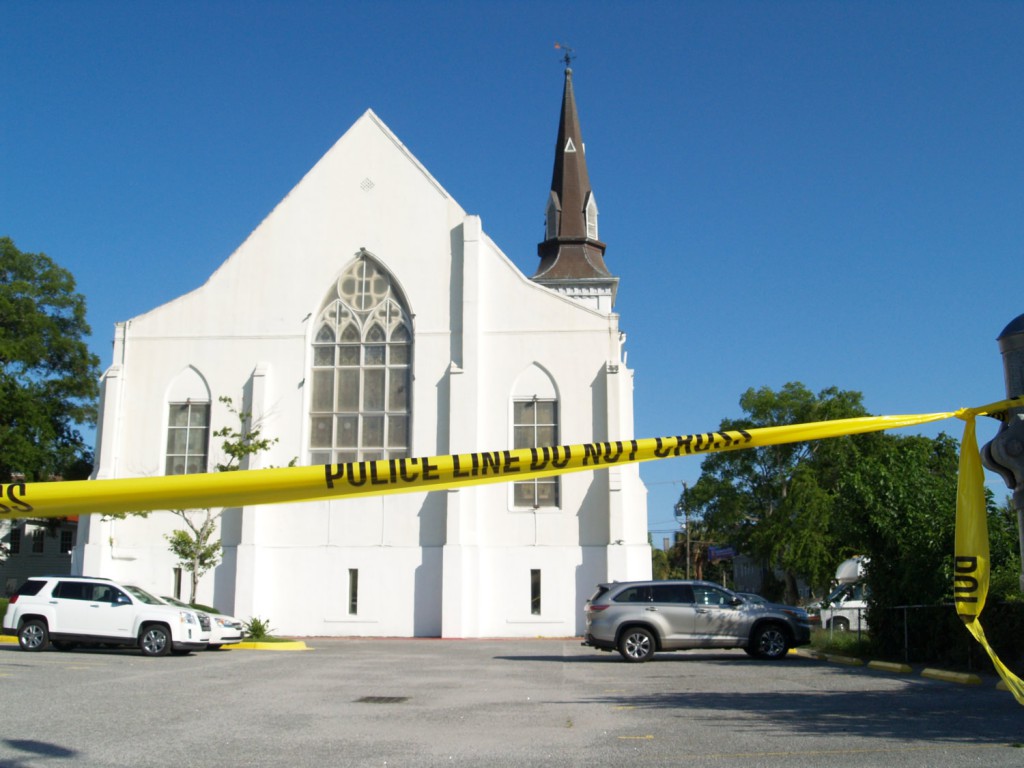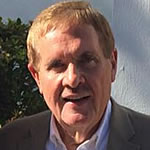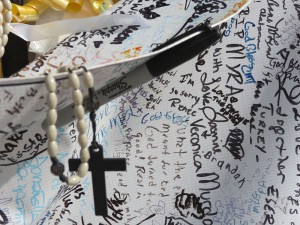
The crime scene at Emanuel AME Church, June 2015. Photo by Andy Brack.
By J. David Gillespie, special to Statehouse Report | The verdict came in around mid-afternoon Thursday, just a couple of hours after the lawyers completed their closing statements and the judge gave his charge to the jury. U.S. v. Dylann Storm Roof: Guilty on all charges. Given the complexity of the indictment—33 counts, many of them alleging hate crimes—the brief time it took was remarkable. The verdict itself was anything but surprising.

Gillespie
I have been in court every one of the trial’s seven days so far. It is incredible to sit near the six rows, always faithfully filled, that are reserved for the victims’ families, friends and survivors of Roof’s murderous June 17, 2015, rampage. It’s interesting to chat with other spectators who come and go and with media people gathered from around the country. It’s surreal to see the perpetrator sitting ahead of us, very close by.
Unbridled emotions, mainly anger and grief, surfaced over the days that the narrative unfolded. The government opened with the heartrending testimony of Felicia Sanders. She was one of two adult survivors of the attack. We listened in horror as she testified. We realized the depth of her grief as she discussed how her son and aunt were killed by Roof.
There was Roof’s racist manifesto, along with hundreds of visual images, including:
- Selfies of Roof with racist flags and symbols and with that Glock .45 murder weapon;
- Grisly 360-degree movable scans revealing dead bodies and blood and spent magazines and shell casings;
- Surveillance footage of Roof leaving Emanuel AME Church after punishing its innocents for being black, sentencing them to death for the “sin” of taking too seriously the words of Jesus that “I was a stranger and you took me in.”
And there was that confession video, two hours long, that was taken by two FBI agents in Shelby, N.C., where local police apprehended Roof.
I did it, he said. How many did you kill? they asked. I don’t know. Maybe five. Why did you do it? I had to, he said — blacks are raping our women, taking over the country. There used to be KKK and skinheads. No one is doing anything for whites these days.
Who is your best friend? they asked. I don’t have one, he said You killed innocent people worshipping in their church. Yes, but if I went into a black neighborhood and killed a drug dealer it wouldn’t have the same impact. Why Charleston and Emanuel AME? I could have chosen a black church in Columbia. But Charleston is historic. I like to come to Charleston. Emanuel AME is a historic black church and so I chose it. (NOTE: Conversation partly paraphrased.)
It was on Wednesday, the day before the verdict came in, that I felt most affected by the grim testimony, by the course of events. There were just two witnesses that day. One was Dr. Erin D. Presnell, the forensic pathologist at Medical University of South Carolina who over a four-day period in June 2015 autopsied the bodies of the nine Mother Emanuel victims. Using individual diagrams and X-rays, she described the trauma to each body. How many bullets (“projectiles”) entered each human being? The range was 5 to 10. The oldest, an 87-year-old woman named Susie Jackson, was hit 10 times by the issue from Roof’s Glock .45). The cause of death in each case? The multiple traumas but in particular bullets reaching hearts, aortas, lungs and kidneys, she said. Beneath the clinical empiricism of the testimony, I sensed the sadness and anger of Dr. Presnell as she autopsied and this week testified about what she had found.
 And then from penultimate to ultimate, there came the testimony of Polly Sheppard, the woman Roof found hiding under a table and praying. “Shut up!” he said before telling her t he would let her live so that she could tell the story of what happened in that room. And that was the story she told in court Wednesday. If there were spectators in the courtroom who held back tears, it had to have been out of a prodigious resolve.
And then from penultimate to ultimate, there came the testimony of Polly Sheppard, the woman Roof found hiding under a table and praying. “Shut up!” he said before telling her t he would let her live so that she could tell the story of what happened in that room. And that was the story she told in court Wednesday. If there were spectators in the courtroom who held back tears, it had to have been out of a prodigious resolve.
Sheppard spoke individually of each of her nine friends killed on June 17. She described the horror that night: of Daniel Simmons, gunned down as he tried to reach and help his already-fallen pastor, Clementa Pinckney; of the youngest victim, Tywanza Sanders, shot and killed vainly trying to assist the eldest, his great aunt. In grief and desperation that night, Sheppard reached for the phone of a dead friend and called 911. Her testimony ended with a recording, played in court, of the chilling dialogue between her and the 911 operator. “He’s a white dude. He’s in here. He’s reloading.” “Hang on, Ms. Polly. You’re doing great. I’m sending help.”
Spectators rose and stood in unison as Polly Sheppard left the witness stand. That gesture of respect was extraordinary, maybe unique, in judicial proceedings. The defendant, who sat looking detached throughout the trial, did not turn toward Sheppard as she gave her testimony. He kept his seat as she exited the courtroom.
U.S. District Judge Richard Gergel is an able, effective, no-nonsense judge. Led by Assistant U.S. Attorney Jay Richardson, the prosecution produced a powerful, compelling narrative. David Bruck, one of the nation’s most eminent defense lawyers in capital cases, did all he could for Roof. But he rested his case without calling Roof or any other defense witness. Bruck has been stymied by objections to the relevance of his presentation of his client as a friendless, delusional loner and also by Roof’s resolve to defend himself in the coming second. part to the trial.
After a hiatus for the holidays, the trial will resume for the sentencing phase on or around Jan. 3, 2017. The 12 jurors (by my count, 10 women, 2 men; 9 whites, 3 African Americans) who found him guilty will, following additional testimony, decide whether to sentence Roof to die or spend the rest of his life in prison without the possibility of release.
What came out in court sickened me. But it was necessary. I believe “justice for all” in our national Pledge of Allegiance was done. And I do hope this trial brought some sense of closure to the dear victims and their families – whatever the outcome of the sentencing phase that’s ahead.
David Gillespie, a Charleston resident, is a retired political scientist and former chief academic officer at Presbyterian College. His late 2015 book on the murders at Emanuel AME Church and their impact upon Charleston and South Carolina is titled “Race Murder, Christian Forgiveness, and Revolutionary Change in Charleston, South Carolina: A Seminal Moment in American History.” It was the first book to be published on the topic.
- Have a comment? Send to: editor@charlestoncurrents.com



 We Can Do Better, South Carolina!
We Can Do Better, South Carolina!

























3 Comments